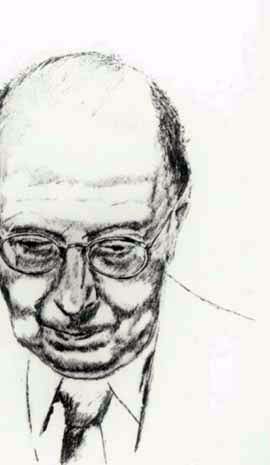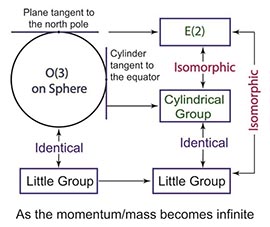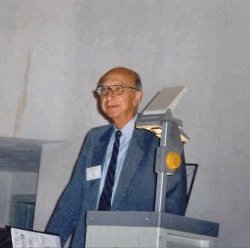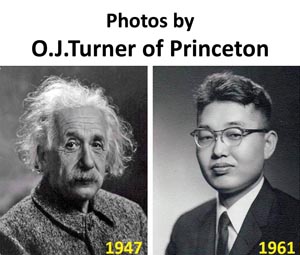Einstein and Group Contractions
When Einstein introduced Lorentz covariance for Newtonian particle dynamics, the question was how he could explain the fact that Newton's law is perfectly consistent with the Galilei system. The explanation was and still is that Lorentz transformations become Galilei transformations in the limit of small velocity or large velocity of light.
- This is of course very easy to say and write down the formulas, but
the precise group theoretical treatment was not achieved until 1953
when Erdal Inonu and Eugene Wigner published a paper on group
contractions [Proc. Nat. Aca. Sci. 39, 510 (1953)].
They explained precisely how the six generators of
the Lorentz group become the six generators of the Galilei group.
You may be interested in
Inonu's review paper given at the
Workshop on Quantum Groups, Deformations and Contractions
(Istanbul, Turkey, 1997).
- In the same paper, Inonu and Wigner give a detailed exposition
of the contraction of the O(3) rotation group into the E(2) group,
namely the Euclidean group in two-dimensional space consisting
of rotations around the origin and translations in two orthogonal
directions. We shall see what effect this has in studying internal
space-time symmetries of relativistic particles.
In his 1939 paper on the inhomogeneous Lorentz group [Ann. Math. 40, 149], Wigner showed that the internal space-time symmetries of massive and massless particles are isomorphic to O(3) (three-dimensional rotation group) and E(2) (two-dimensional Euclidean group) respectively. They are known as Wigner's little groups.
The O(3)-like symmetry for a massive particle corresponds to the spin of the particle. As for the E(2)-like symmetry for a massless particle, it is not difficult to associate the rotational degree of freedom to the helicity. After some stormy history, it has been now established that the two translational degrees of freedom of E(2) correspond to the gauge degree of freedom.
- Then the following question arises. Can the E(2)-like little group
for massless particles be obtained from the O(3)-like little group
by a group contraction procedure. The answer to this question is
YES. You may be interested in the following papers.
- Y. S. Kim and E. P. Wigner, "Cylindrical group and massless
particles,"
J. Math. Phys. Vol. 28, pages 1175-1179 (1987).
- Y. S. Kim and E. P. Wigner, "Space-time geometry of relativistic
particles,"
J. Math. Phys. Vol. 31, pages 55-60 (1990).
The following figure summarizes how the E(2)-like little group can be obtained from the O(3)-like little group by group contraction or the high-speed limit.
Massive/Slow between Massless/Fast Energy
MomentumE=p2/2m Einstein's
E=(m2 + p2)1/2E=p Spin, Gauge,
HelicityS3
S1 S2Wigner's
Little GroupS3
Gauge Trans.You may visit a separate webpage for detailed explanation of this table.
We worked hard, and published a paper in 1987 providing a solution to this problem. The point is that the little-group is only iomorphic to the two-dimensional Euclidean group. The little group takes the form of transformations on a cylindrical surface consisting of rotations (helicity) and up-down translations (gauge transformations).
Finally it is my pleasure to show my photos with the main characters of group contractions. One is with Eugene Wigner and the other is with Erdal Inonu.
- with Wigner (1986).
- with Inonu (1997). The other gentleman in the photo is Nikolaj Gromov from Russia. He now holds the world championship on group contractions.
Y.S.Kim (2005.10.21)
- Y. S. Kim and E. P. Wigner, "Cylindrical group and massless
particles,"
J. Math. Phys. Vol. 28, pages 1175-1179 (1987).
 Erdal Inonu giving the talk at the workshop (1997).
Erdal Inonu giving the talk at the workshop (1997).
|
- copyright@2005 by Y. S. Kim, unless otherwise specified.
Wigner portrait by Bulent Atalay (1978).
- Click here for Y. S. Kim's
home page.

|
| Why is he with Einstein? |